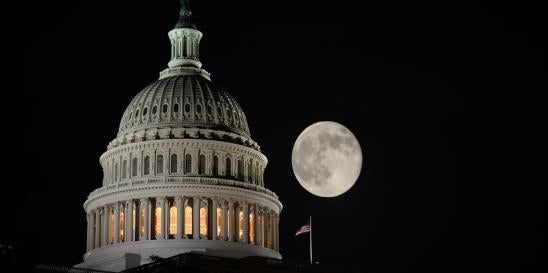Smackdowns and Shutdowns on Capitol Hill. It is a good thing that Thanksgiving is around the corner, because it seems like the stress level on Capitol Hill is very high and our federal legislators could use a break. This week, Representative Kevin McCarthy (R-CA), the immediate past Speaker of the U.S. House of Representatives, allegedly elbowed or shoved Representative Tim Burchett (R-TN) as he walked by him in the hallway. (It is probably no coincidence that Burchett was one of eight Republicans who voted to remove McCarthy from the speakership.) Additionally, former mixed martial arts fighter and current junior U.S. senator from Oklahoma, Markwayne Mullin (R-OK), challenged the International Brotherhood of Teamsters’ president, Sean O’Brien, to a fight during a hearing of the U.S. Senate Committee on Health, Education, Labor and Pensions (HELP) before which O’Brien was testifying on Tuesday. With all of this legislative physical activity and eyebrow-raising posturing, it was perhaps fitting that Dwayne “The Rock” Johnson paid a visit to Capitol Hill this week.
Despite all the shenanigans, the U.S. Congress actually accomplished something by agreeing to an unusual “two-step” continuing resolution to avoid a government shutdown that would have started at midnight, November 17–18, 2023. President Biden signed the measure yesterday, on November 16. Like the September 30, 2023, appropriations deal, this week’s action kicks the spending debate down the road once again. This time, however, funding for agencies covered by four bills concerning agriculture, energy and water, military construction and veterans affairs, and transportation will continue through January 19, 2024. Funding for other federal agencies—including the U.S. Department of Labor (DOL), National Labor Relations Board (NLRB), U.S. Equal Employment Opportunity Commission (EEOC), and U.S. Department of Homeland Security (DHS)—will continue through February 2, 2024. So, if you are a fan of government shutdown drama, you have more to look forward to in 2024.
House Spending Bill Addresses Workplace Issues. This week’s continuing resolution has bought Congress some time to continue work on individual appropriations bills, including H.R. 5894, the House version of the Senate’s Departments of Labor, Health and Human Services, and Education, and Related Agencies Appropriations Act, 2024 (S. 2624). The text of the House bill contains several provisions that address some of the Buzz’s favorite workplace policy issues. For example, H.R. 5894 would prohibit the DOL from using any appropriated funds “to alter or affect the administration, implementation, or enforcement” of the Trump-era independent contractor rule, thereby preventing the DOL from finalizing its current proposed independent contractor rule.
The bill would similarly prohibit the NLRB from changing its existing joint-employer standard, which focuses on direct and immediate control. (As described below, the Board has issued a new joint-employer regulation that becomes effective on February 26, 2024.) Finally, the bill maintains a long-standing prohibition on the Board’s use of funds to allow for “voting through any electronic means in an election to determine a representative for the purposes of collective bargaining.” Of course, these riders are unlikely to be acceptable in the Democratic-controlled Senate—and they have already met with objection from the White House—but they serve to demonstrate that these labor policy issues are important for some members of Congress.
Board Extends Joint Employer Effective Date. On November 16, 2023, the NLRB announced that it would extend the effective date of its recently finalized joint-employer rule from December 26, 2023, to February 26, 2024. According to the announcement, the purpose of the postponement is to “facilitate resolution of legal challenges with respect to the rule.” The announcement also states that the new rule “will only be applied to cases filed after the rule becomes effective.”
OSHA Walkaround Proposal Moves Forward. November 13, 2023, was the deadline for stakeholders to submit comments in response to the Occupational Safety and Health Administration’s (OSHA) “walkaround” regulatory proposal. Like most of the proposed regulations that the Buzz is tracking, this regulation is expected to be finalized in the late spring or summer of 2024.
DHS/DOL Make More H-2B Visas Available. Today, November 17, 2023, DHS and the DOL published a joint temporary final rule “making available an additional 64,716 H-2B temporary nonagricultural worker visas for fiscal year (FY) 2024, on top of the statutory cap of 66,000 H-2B visas that are available each fiscal year.” The allocations will be made as follows:
• October 1, 2023, through March 31, 2024 (first half of FY 2024): 20,716 immediately available visas limited to returning workers. Employment must start on or before March 31, 2024.
• April 1, 2024, through May 14, 2024: 19,000 visas for returning workers when employment starts on or after April 1, 2024, and no later than May 14, 2024.
• May 15, 2024, through September 30, 2024: 5,000 visas for returning workers when employment starts on or after May 15, 2024, and no later than September 30, 2024.
• 20,000 visas allocated to nationals of El Salvador, Guatemala, Honduras, Haiti, Colombia, Ecuador, and Costa Rica throughout FY 2024, regardless of returning worker status.
According to the press release accompanying the rule, “By making these supplemental visas available at the outset of FY 2024, the Departments will help ensure U.S. businesses with workforce needs are able to plan ahead and find the seasonal and temporary workers they need.” Regarding filing deadlines, the notice states, “DHS will not accept any H-2B petitions under provisions related to the FY 2024 supplemental numerical allocations after September 16, 2024.”
Congress Moves to Washington, D.C. On November 17, 1800—223 years ago today—Congress met for the first time in the Capitol Building in Washington, D.C. Prior to finding its permanent home in Washington, D.C., the United States’ capital moved eight times between 1776 and 1800. Philadelphia served as the capital for sixteen nonconsecutive years, and during the Revolutionary War, the capital temporarily located to Lancaster (for just one day) and then York in Pennsylvania, as well as Baltimore, in order to escape British capture. The capital also spent time in Princeton, New Jersey; Annapolis, Maryland; Trenton, New Jersey; and New York City. Subsequently, as part of the Compromise of 1790, the Residence Act required the relocation of the capital to Washington, D.C., by 1800. When Congress moved into its new confines 223 years ago, construction of the building was still underway. President John Adams addressed Congress several days later, stating, “Although there is some cause to apprehend that accommodations are not now so complete as might be wished, yet there is great reason to believe that this inconvenience will cease with the present session.” It was the last time a president would deliver an annual address to Congress for 113 years until President Woodrow Wilson reestablished the practice of delivering the State of the Union address in 1913.




 i
i


